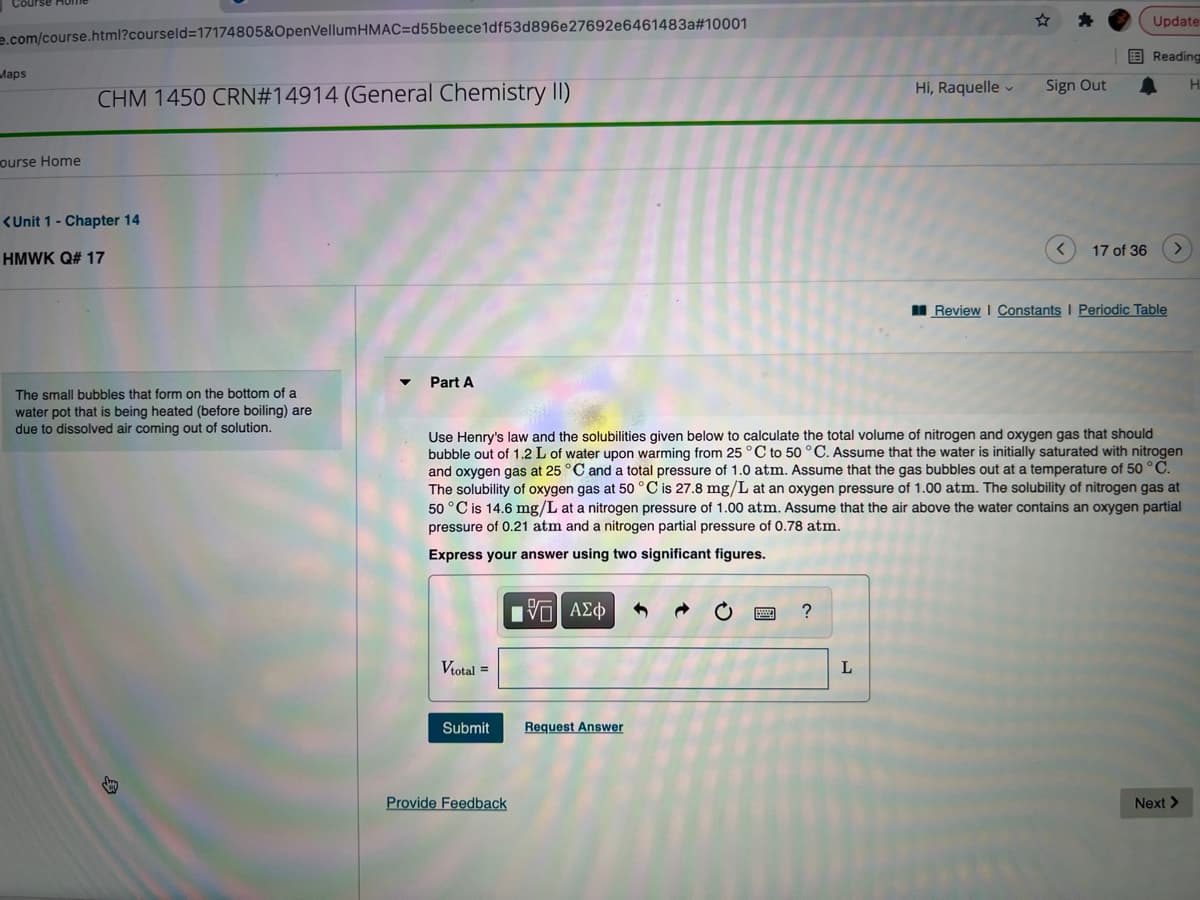Part A Use Henry's law and the solubilities given below to calculate the total volume of nitrogen and oxygen gas that should bubble out of 1.2 L of water upon warming from 25 °C to 50 °C. Assume that the water is initially saturated with nitrogen and oxygen gas at 25 °C and a total pressure of 1.0 atm. Assume that the gas bubbles out at a temperature of 50 ° C. The solubility of oxygen gas at 50 °C is 27.8 mg/L at an oxygen pressure of 1.00 atm. The solubility of nitrogen gas at 50 °C is 14.6 mg/L at a nitrogen pressure of 1.00 atm. Assume that the air above the water contains an oxygen partial pressure of 0.21 atm and a nitrogen partial pressure of 0.78 atm. Express your answer using two significant figures. Hνα ΑΣφ ? Vtotal = Submit Request Answer
Part A Use Henry's law and the solubilities given below to calculate the total volume of nitrogen and oxygen gas that should bubble out of 1.2 L of water upon warming from 25 °C to 50 °C. Assume that the water is initially saturated with nitrogen and oxygen gas at 25 °C and a total pressure of 1.0 atm. Assume that the gas bubbles out at a temperature of 50 ° C. The solubility of oxygen gas at 50 °C is 27.8 mg/L at an oxygen pressure of 1.00 atm. The solubility of nitrogen gas at 50 °C is 14.6 mg/L at a nitrogen pressure of 1.00 atm. Assume that the air above the water contains an oxygen partial pressure of 0.21 atm and a nitrogen partial pressure of 0.78 atm. Express your answer using two significant figures. Hνα ΑΣφ ? Vtotal = Submit Request Answer
Chemistry
10th Edition
ISBN:9781305957404
Author:Steven S. Zumdahl, Susan A. Zumdahl, Donald J. DeCoste
Publisher:Steven S. Zumdahl, Susan A. Zumdahl, Donald J. DeCoste
Chapter1: Chemical Foundations
Section: Chapter Questions
Problem 1RQ: Define and explain the differences between the following terms. a. law and theory b. theory and...
Related questions
Question
Part A

Transcribed Image Text:Update
e.com/course.html?courseld=17174805&OpenVellumHMAC=Dd55beece1df53d896e27692e6461483a#10001
Reading
Маps
Hi, Raquelle -
Sign Out
H
CHM 1450 CRN#14914 (General Chemistry II)
ourse Home
<Unit 1- Chapter 14
17 of 36
HMWK Q# 17
I Review I Constants I Periodic Table
Part A
The small bubbles that form on the bottom of a
water pot that is being heated (before boiling) are
due to dissolved air coming out of solution.
Use Henry's law and the solubilities given below to calculate the total volume of nitrogen and oxygen gas that should
bubble out of 1.2 L of water upon warming from 25 °C to 50 °C. Assume that the water is initially saturated with nitrogen
and oxygen gas at 25 °C and a total pressure of 1.0 atm. Assume that the gas bubbles out at a temperature of 50 °C.
The solubility of oxygen gas at 50 °C is 27.8 mg/L at an oxygen pressure of 1.00 atm. The solubility of nitrogen gas at
50 °C is 14.6 mg/L at a nitrogen pressure of 1.00 atm. Assume that the air above the water contains an oxygen partial
pressure of 0.21 atm and a nitrogen partial pressure of 0.78 atm.
Express your answer using two significant figures.
?
Viotal =
L
Submit
Request Answer
Provide Feedback
Next >
Expert Solution
This question has been solved!
Explore an expertly crafted, step-by-step solution for a thorough understanding of key concepts.
This is a popular solution!
Trending now
This is a popular solution!
Step by step
Solved in 2 steps with 2 images

Knowledge Booster
Learn more about
Need a deep-dive on the concept behind this application? Look no further. Learn more about this topic, chemistry and related others by exploring similar questions and additional content below.Recommended textbooks for you

Chemistry
Chemistry
ISBN:
9781305957404
Author:
Steven S. Zumdahl, Susan A. Zumdahl, Donald J. DeCoste
Publisher:
Cengage Learning

Chemistry
Chemistry
ISBN:
9781259911156
Author:
Raymond Chang Dr., Jason Overby Professor
Publisher:
McGraw-Hill Education

Principles of Instrumental Analysis
Chemistry
ISBN:
9781305577213
Author:
Douglas A. Skoog, F. James Holler, Stanley R. Crouch
Publisher:
Cengage Learning

Chemistry
Chemistry
ISBN:
9781305957404
Author:
Steven S. Zumdahl, Susan A. Zumdahl, Donald J. DeCoste
Publisher:
Cengage Learning

Chemistry
Chemistry
ISBN:
9781259911156
Author:
Raymond Chang Dr., Jason Overby Professor
Publisher:
McGraw-Hill Education

Principles of Instrumental Analysis
Chemistry
ISBN:
9781305577213
Author:
Douglas A. Skoog, F. James Holler, Stanley R. Crouch
Publisher:
Cengage Learning

Organic Chemistry
Chemistry
ISBN:
9780078021558
Author:
Janice Gorzynski Smith Dr.
Publisher:
McGraw-Hill Education

Chemistry: Principles and Reactions
Chemistry
ISBN:
9781305079373
Author:
William L. Masterton, Cecile N. Hurley
Publisher:
Cengage Learning

Elementary Principles of Chemical Processes, Bind…
Chemistry
ISBN:
9781118431221
Author:
Richard M. Felder, Ronald W. Rousseau, Lisa G. Bullard
Publisher:
WILEY